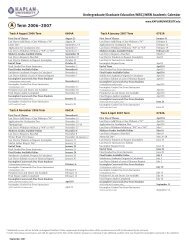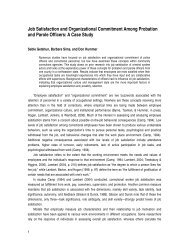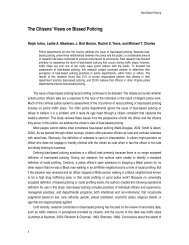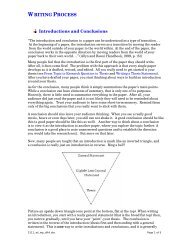Adult Probation Department Mental Health Unit: An Outcomes ...
Adult Probation Department Mental Health Unit: An Outcomes ...
Adult Probation Department Mental Health Unit: An Outcomes ...
- No tags were found...
Create successful ePaper yourself
Turn your PDF publications into a flip-book with our unique Google optimized e-Paper software.
screens for this condition due to patterns of use and treatment processes that differ from those of personswho are not mentally ill (Wolford et al., 1999).Treatment of the NoncompliantA number of individual, societal, and systematic factors contribute to treatment noncompliance amongmentally ill probationers. They include lack of entitlements, homelessness, poverty, poor insight into theirillnesses, medication noncompliance, substance abuse, and lack of access to dual diagnosis treatment. Inworking with probationers, the <strong>Mental</strong> <strong>Health</strong> <strong>Unit</strong> helps negotiate each barrier to reduce the chance fornoncompliance, particularly for two factors: the loss of entitlements and medication noncompliance.<strong>Probation</strong>ers experience a discontinuation of benefits when they are incarcerated. Once released theprobationer must see a psychiatrist again and start a regimen of psychotropic medications. Many psychiatricmedications cause side effects such as facial tics, blurred vision, dry mouth, slurred speech, rapid weightgain, and slowed gait. These side effects cause discomfort and make the probationer less likely to continueuse of these medications. <strong>Probation</strong>ers often tell MHU officers that these side effects make other peoplereact differently to them and cause them to isolate themselves from others. If the medications alleviate somesymptoms, probationers may think they can stop the medications and maintain their current functioning. Atthat point, the probationer might require hospitalization to control symptom renewal.Issues of Substance AbuseSubstance abuse has become an increasingly more significant factor in the mentally ill probationer’snoncompliance with treatment and probation. Hartwell (2003) states that living in the community with thedouble stigma of mental illness and a criminal background is problematic for many probationers. High ratesof substance abuse among this population compound the issues related to helping those with mental illness(Draine & Solomon, 1994; Solomon & Draine, 1999a; Swanson, Borum, & Swartz, 1996). As this studyshows, 70% of the MHU census was classified as having a dual diagnosis (co-occurring mental illness andsubstance use disorder). It has become more and more important that each MHU officer be, first, familiarwith the drug culture and then proficient in working with probationers with these dual diagnoses. Weencounter mentally ill probationers in differing stages of their addiction (relapse, sobriety, maintenance,binge using, etc.), and our experience has shown us that we must intervene before they are arrested on arelated offense, decompensate, and need to be hospitalized. One option is facilitating admission todetoxification and inpatient dual diagnosis treatment. One of the barriers we have encountered is drugtreatment facilities that have few available dual diagnosis beds or few staff who can deal effectively with thedual diagnosis. A probationer must be stable enough to participate in the treatment environment. Somefacilities require psychiatric clearance before an admission, which poses another barrier to addictiontreatment. A probationer with a dual diagnosis may be slightly symptomatic, and believing the probationerwould be disruptive, substance abuse professionals might deny that individual entry into treatment. Theseissues hinder access to those who need these services at such a critical time.Methods3
















